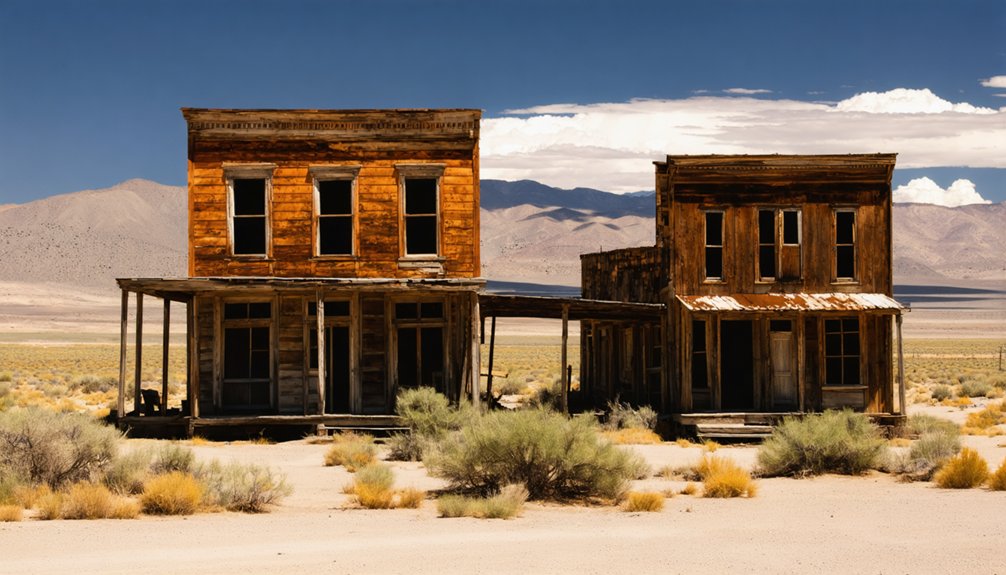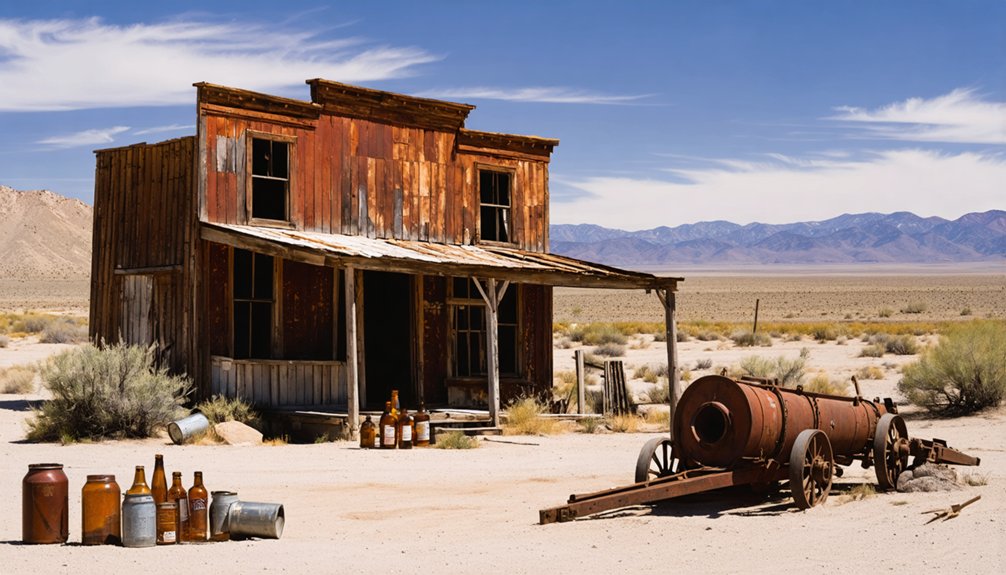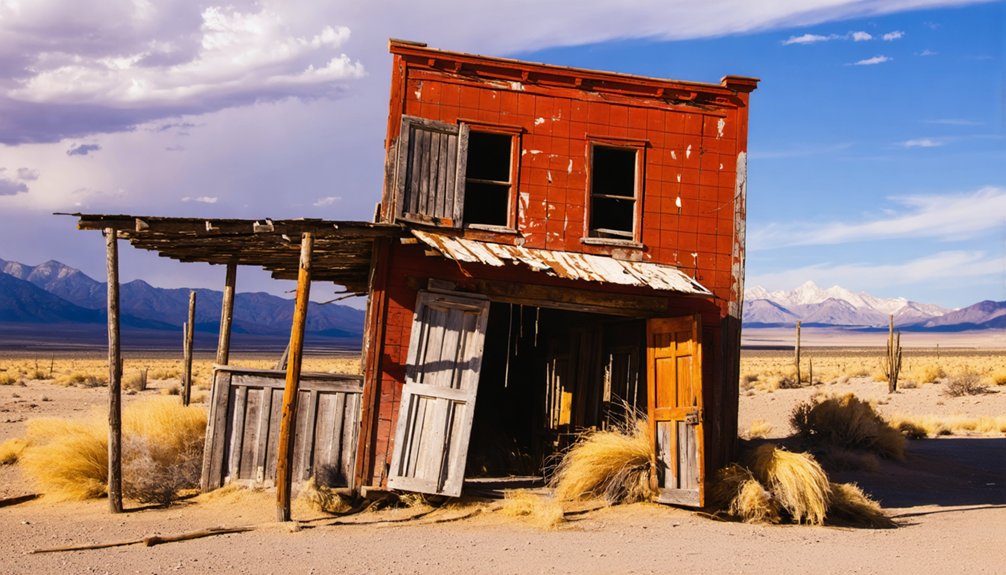You’ll find Round Mountain about 60 miles north of Tonopah, where Louis D. Gordon’s 1906 gold discovery sparked one of Nevada’s richest mining booms. The town’s innovative hydraulic mining and 100-ton mill helped produce over 145,000 ounces of gold during peak years. Though most residents relocated to nearby Hadley by 1959, leaving scattered ruins behind, today’s modern mining operations continue the area’s golden legacy through massive open-pit excavations and advanced processing techniques.
Key Takeaways
- Round Mountain began as a gold mining camp in 1906 after Louis D. Gordon’s discovery, growing rapidly with miners from nearby Goldfield.
- The town reached its peak population of 234 during the 1939 mining boom before declining significantly by 1959.
- Most residents relocated to nearby Hadley when the placer mill closed in 1949, leaving Round Mountain largely abandoned.
- Original buildings and mill structures now exist as ruins, with the historic townsite moved multiple times for modern mining operations.
- The site remains an active mining area with large open-pit operations, though the original ghost town structures continue deteriorating.
The Birth of a Gold Mining Frontier
Three major developments marked the birth of Round Mountain’s gold mining frontier in 1906: Louis D. Gordon’s momentous gold discovery, the rapid influx of determined miners, and the evolution of mining techniques.
You’ll find that the initial gold discovery was modest yet promising, with visible metallic gold and placer deposits appearing in surface trenches on Gordon’s land.
As word spread, prospectors rushed in from nearby Goldfield, quickly implementing both hard-rock and placer mining methods. They started with dry washing techniques for the placer deposits, but soon shifted to more efficient hydraulic mining when water became available from mountain creeks. The operation proved highly successful, with the mine reaching 800 feet in depth and incorporating a 100-ton mill for processing. The site would later become one of the first major U.S. operations to utilize heap leaching for gold extraction.
Early Mining Methods and Innovation
You’ll find that Round Mountain’s early mining methods were shaped by necessity, as miners first relied on drywashing techniques due to water scarcity before implementing an ambitious 9-mile pipeline from Jett Canyon.
When water finally flowed, hydraulic mining became the preferred method, with powerful jets of water blasting gold-bearing gravels into sluices for processing. During early hydraulic operations, miners recovered fine gold and nuggets worth $20,000 from their first cleanup.
The miners also tackled harder challenges underground, driving shafts up to 800 feet deep to extract high-grade ore from veins, which they processed in 100-ton mills to recover the precious metal.
Hydraulic Mining Operations
While early prospectors initially relied on dry washing techniques due to limited water availability, Round Mountain’s mining operations underwent a significant transformation with the introduction of hydraulic mining methods.
Through innovative water management solutions, including a 9-mile pipeline from Jett Canyon and water sourcing from Shoshone and Jefferson creeks, miners could now blast gold-bearing gravels with high-pressure water. The Sunnyside Mill expansion in 1926 further enhanced the efficiency of these hydraulic operations.
- Massive hydraulic operations created an impressive pit measuring 200 feet deep, 4,000 feet long, and 1,800 feet wide
- Mining technology advanced to include scarifying plates, electric shovels, and conveyors to handle tough boulder conditions
- The operation yielded about 145,000 ounces of gold during peak periods in the 1950s
Despite these achievements, water scarcity and safety concerns eventually led miners to shift toward other extraction methods.
Hard Rock Extraction Methods
Before the advent of large-scale operations, Round Mountain’s early hard rock mining relied on traditional manual extraction from high-grade veins containing visible gold.
You’d find miners working these rich veins using hand tools, following the ore bodies down to depths of about 800 feet. The Los Gazabo vein proved especially productive, stretching roughly 1,000 feet along a gentle 15-degree northward dip.
The hard rock mining techniques evolved as operations grew more sophisticated.
Miners crushed and processed ore through 100-ton capacity mills, designed to handle the unique combination of limonite, quartz, and pyrite.
These early efforts paid off handsomely, with bullion recovery exceeding $700,000 in value during just the first two years of milling operations.
Life in a Bustling Mining Community
Life in Round Mountain revolved entirely around the precious metal that brought everyone there – gold. You’d find a tight-knit community of mining families and workers, with the population swelling to over 234 during the peak mining booms of 1939. The community dynamics shaped daily social interactions around the mining operations that drove the town’s existence.
- Miners faced dangerous conditions working underground at depths of 800 feet, while their families built lives around the bustling mining schedule.
- Local businesses and services flourished to support the growing community until the town’s eventual relocation.
- Multiple cycles of boom and bust tested residents’ resilience, with many staying through the shifts from underground to open pit mining.
The Golden Years of Production
You’d be amazed by Round Mountain’s early success, which brought in over $700,000 in gold bullion during just the first two years of production with its 100-ton mill.
The district’s prosperity peaked between 1925 and 1937, generating what would be worth $145 million in today’s money. The mine would go on to produce approximately 9.1 million ounces of gold between 1977 and 2004.
Million-Dollar Mining Hub
The Round Mountain mine emerged as one of the world’s largest epithermal gold deposits, transforming from modest beginnings into a powerhouse operation that’s produced over 10 million ounces of gold since 1906.
The Kinross-Barrick partnership has jointly operated this massive gold producer since 2006, demonstrating the mine’s continued strategic importance in modern times.
This gold rush powerhouse showcased Nevada’s rich mining heritage, starting with impressive early profits of $709,184 in just two years and maintaining $20,000 monthly yields through hydraulic operations.
The mine’s Phase X underground development began in early 2023, marking a significant expansion of mining capabilities.
You’ll find the mine’s remarkable evolution reflected in these milestones:
- Production skyrocketed from 4.3 tonnes in 1985 to 23.5 tonnes by 2002
- Advanced processing combines crushing, milling, and heap leaching, handling 30,000 tonnes daily
- Recovery rates improved from 67% to 80% with deeper ore extraction
Today, Round Mountain continues as an essential economic engine, contributing to Nevada’s $9.5 billion mining industry value.
Early Fortune Rush Days
Gold fever struck Round Mountain in February 1906 when prospector Louis D. Gordon discovered rich surface gold deposits. Within two years, you’d have witnessed a classic gold rush unfold as miners flocked to stake their claims, working both underground veins and placer deposits.
The boom transformed the area into a bustling mining camp supporting hundreds of residents. The mining legacy took off quickly with an 800-foot-deep operation and a 100-ton mill churning out impressive yields.
Those first two years alone produced over $709,000 in gold bullion. You’d have seen water pipes snaking down from mountain creeks to support hydraulic mining, while underground, miners chased rich veins deeper into the earth.
From Boom to Decline
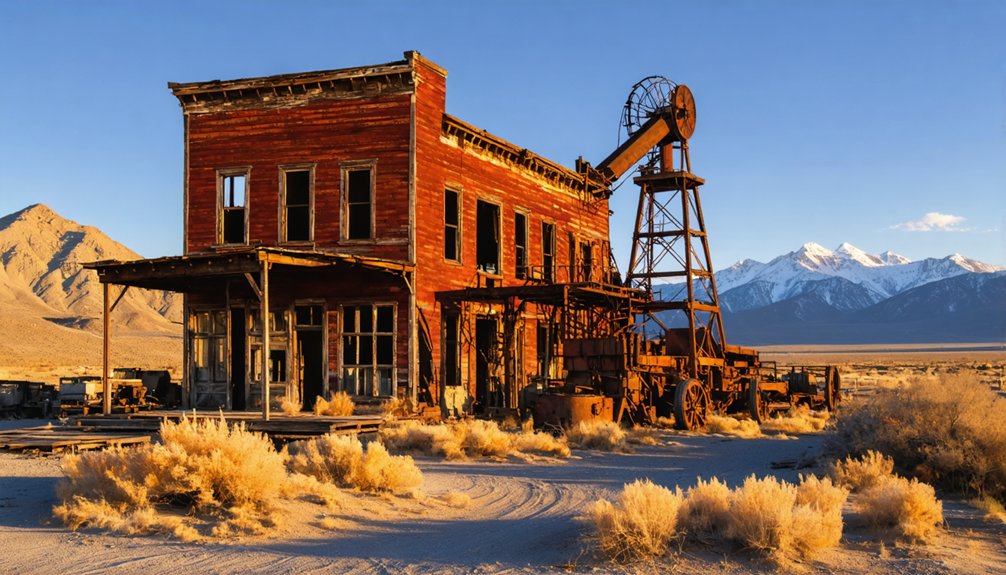
While discovery of gold in 1906 sparked Round Mountain’s meteoric rise, no one could’ve predicted its eventual transformation into a ghost town.
The social dynamics shifted dramatically as mining operations evolved from underground tunnels to surface operations, forever changing the environmental impact on the landscape.
You’ll find the town’s decline marked by these key transformations:
- Underground mining became too dangerous by 1935, though the population held steady at 234 residents.
- The 1949 placer mill’s closure marked a turning point, with gold quality diminishing rapidly.
- By 1959, most residents relocated to nearby Hadley, leaving Round Mountain nearly empty.
The once-bustling mining town that produced millions in gold saw its buildings removed and its community scattered, leaving only scattered ruins to tell its tale of boom and bust.
Modern Mining Operations and Town Relocation
Modern operations at Round Mountain bear little resemblance to its early mining days, with two massive open pits now dominating the landscape where underground tunnels once snaked beneath the earth.
You’ll find the Round Mountain and Gold Hill pits bustling with activity as modern mining techniques extract low-sulfidation epithermal gold deposits. The new heap leach facility spans an impressive 9 million square feet to process extracted ore efficiently.
The town itself has shifted locations several times to accommodate expanding operations. In the 1980s and 1990s, residents moved to newly developed areas away from mining zones, complete with updated facilities and services.
Today’s operations focus heavily on environmental management, with strict waste rock handling protocols and water treatment facilities. The project’s strategic location in the Walker Lane Trend provides excellent road access and infrastructure support.
A second phase of development, launching in 2024-2025, promises to extend the mine’s life by five years, adding roughly 1.5 million ounces to its gold reserves.
Preserving the Legacy of Round Mountain
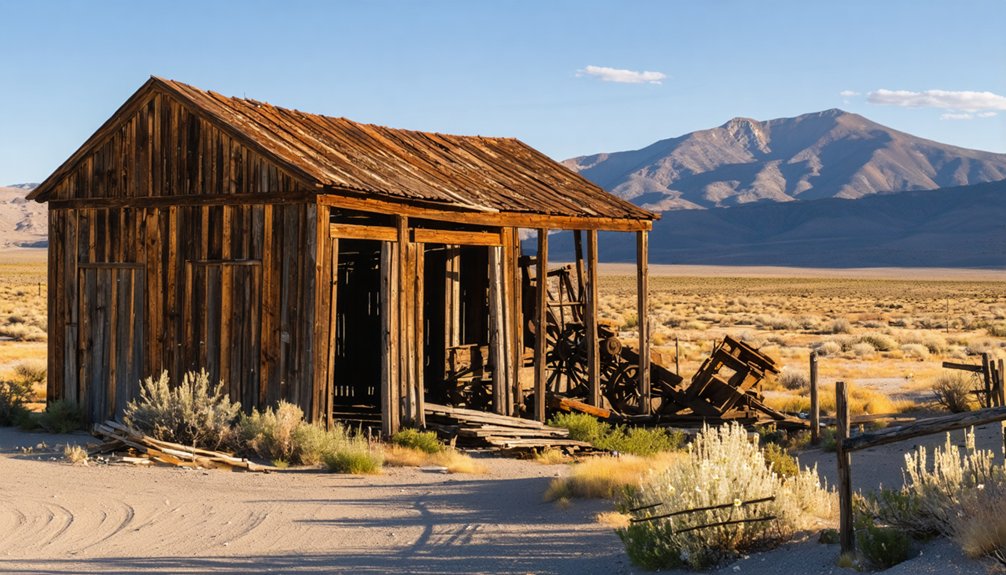
Despite ongoing mining operations, dedicated efforts to preserve Round Mountain’s rich heritage continue through various channels.
Historical documentation through books like “Preserving the Glory Days” and archival collections capture the town’s vibrant past, while state historical markers acknowledge its significance as a long-running gold camp. The discovery of gold in 1905 on Round Mountain marked the beginning of this historic mining settlement.
You’ll find Round Mountain’s legacy preserved through:
- Physical remnants including old mill structures and early 20th-century buildings
- Community engagement through local heritage groups and oral history preservation
- Extensive archival materials including photographs, newspapers, and mining records
Though challenges exist from active mining and natural decay, the combined work of historians, preservation offices, and community members guarantees that Round Mountain’s compelling story endures for future generations to discover and explore.
Frequently Asked Questions
What Native American Tribes Originally Inhabited the Round Mountain Area?
While you’re walking these ancestral lands today, you’ll find they were home to the Western Shoshone, Northern Paiute, and Washoe tribes, whose historical significance shaped Round Mountain’s native heritage.
How Deep Were the Original Mine Shafts at Round Mountain?
You’ll find varying mine shaft depths at Round Mountain, with the deepest reaching 1,200 feet on an incline, while most historical mining techniques focused on shafts between 100-900 feet deep.
What Was the Average Wage for Miners in Round Mountain?
You’ll find today’s miners earn about $27.58/hour ($57,400 yearly) operating modern mining equipment, though labor conditions and wages have evolved markedly since the challenging early days of manual mining work.
Were There Any Major Mining Accidents or Disasters in Round Mountain?
Like a dark cloud over mining safety, you’ll find one significant tragedy: the 2020 bulldozer accident that claimed Robert Larson’s life. Despite strong accident prevention measures, this veteran miner’s death shook the community.
Did Round Mountain Have Any Famous Visitors During Its Peak Years?
You won’t find records of famous visitors or historical figures during Round Mountain’s heyday – most documented visitors were mining executives, company representatives, and regional businesspeople managing day-to-day operations.
References
- https://www.recordcourier.com/news/2019/may/08/round-mountain-slowly-slips-away/
- https://westernmininghistory.com/towns/nevada/round-mountain/
- https://www.nvexpeditions.com/nye/roundmtn.php
- https://special.library.unlv.edu/boomtown/counties/nye.php
- https://shpo.nv.gov/nevadas-historical-markers/historical-markers/round-mountain
- https://www.mininghistoryassociation.org/TonopahGoldMineCamps.htm
- https://pubs.usgs.gov/bul/0725i/report.pdf
- https://westernmininghistory.com/library/38153/page1/
- https://www.leg.state.nv.us/Division/Research/Publications/Bkground/BP87-01.pdf
- https://westernmininghistory.com/mine-detail/10310392/
